TRADITION’s 2025 Book Endorsements – Part III

Today we conclude TRADITION’s yearly tradition of offering up endorsements for summer reading by our esteemed editorial board (see Part I and Part II and peruse all past years’ picks).
Congratulations to Steven Smith of Scarsdale, NY (once again, for the second year in a row!) for being the first to correctly pick the most titles from this year’s list. He wins a year’s subscription to our print journal—join him.
R. Yom Tov ibn Ashbili (Ritva), Sefer ha-Zikkaron
Yitzchak Blau
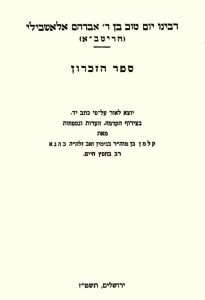
Sefer ha-Zikkaron
I have long harbored an affection for R. Yom Tov ibn Ashbili’s slim volume, Sefer ha-Zikkaron, in which the author defends Rambam from Ramban’s critiques found in the latter’s commentary on the Torah. Ritva is one of the clearest and most incisive commentators on the Talmud and it is exciting to encounter a different aspect of his thought. Despite the fact that he identified more with Ramban’s world of thought and was Ramban’s disciples’ disciple (he studied under Rashba and Ra’ah), he felt that Ramban had been overly harsh in his criticism and that someone of Rambam’s stature deserved defense. It would be a better world if more thinkers defended positions they did not fully agree with. R. Yom Tov manages to combine reverence for Ramban with criticism of his hero for mistreatment of Rambam.
The types of defense are divided between topic-specific analysis and general methodological points. In terms of the latter, Ritva sometimes contends that Ramban was misled by relying on Al-Harizi’s translation of the Guide as opposed to reading either Ibn Tibbon’s translation or the original Arabic. Regarding Rambam’s maverick position on the sacrificial order, Ritva suggests that Ramban focused too much on Rambam’s discussion in Guide III:46 and not enough on what he wrote in III:32.
Ramban writes that Rambam’s theory of egla arufa does not cohere with several details of this ritual. Ritva responds that Rambam already informed the reader that his reasons apply to the mitzva as a whole but that details can be arbitrary (III:26). When it comes to explaining how Shabbat commemorates the Exodus, Ritva makes the intriguing suggestion that this theme was predominantly for the generation that left Egypt so as to appreciate their freedom from bondage every seventh day. Subsequently, the remembrance of creation theme took center stage.
Some answers are much more localized. Rambam did not truly mean that the biblical term “haron af” is restricted to idolatry; he just meant that it is primarily used regarding idolatry. Why should Ramban reject Rambam’s explanation of Moshe’s sin when Hazal also say that Moshe became angry at Mei Meriva? Moshe’s miracles truly were unique in that even the wonders of Yehoshua and Eliyahu were not “before the eyes of all of Israel.”
Despite his commitment to Rambam’s honor, Ritva refuses to defend Rambam’s position that Hebrew is leshon ha-kodesh because of its refined vocabulary. It is fascinating that he was willing to defend the ideas that the three wayfarers only visited Avraham in a dream (according to Rambam, one cannot encounter angels in physical form) and that sacrifices are a concession to historical context, but avers when it comes to Rambam’s stance on Hebrew.
Kalman Kahane’s introduction to the 1956 Mosad HaRav Kook edition notes a sharp irony. Ramban valued the honor of earlier authorities as he defended Behag from Rambam’s censures as well as Rif from the disagreements of Ba’al Hamaor. Here, a member of his own school of thought defended an earlier authority against the strictures of Ramban himself.
Simon Critchley, Mysticism (New York Review Books)
Natan Levin, Editorial Assistant
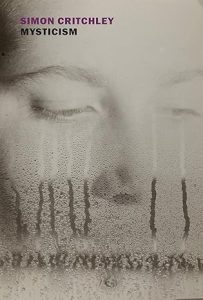
Mysticism
Mysticism, Evelyn Underhill suggests, may be defined as “experience in its most intense form.” Taking Underhill’s pithy formulation as his point of departure, Simon Critchley asks his reader, “Wouldn’t you like to have a taste of this intensity?” In Mysticism, Critchley offers a distinctive response to the challenge of discussing this ostensibly ineffable mode of being. Central to his contribution is his rejection of purely immediate mystical encounter. Rather than disposing of conceptual mediation entirely as does Buber, Critchley advocates for what he terms “mediated immediacy”—“layering of concepts with experience” that creates a mutually reinforcing dialectic between intellectual analysis and direct spiritual encounter. This framework enables Critchley to identify and analyze what he sees as the central theme of mystical tradition: negation—approaching God “obliquely” through the systematic annihilation of created reality and the self in order to achieve divine union.
Critchley locates the primacy of negation across different forms and traditions: Dionysius’ apophatic theology, wherein God can only be apprehended through what He is not; Flannery O’Connor’s yearning to “push myself aside” so that the divine can work through her writing; and T.S. Eliot’s paradoxical notion that artistic achievement requires “continual self-sacrifice” and self-immolation of the writer. Most radically, Critchley presents Meister Eckhart’s startling prayer: “I pray God to rid me of God”—a desire for such complete unity that even the final distinction between worshipper and worshipped dissolves into absolute oneness.
Julian of Norwich’s vision of a divinely bestowed hazelnut provides an illustrative example. The tiny object’s very smallness directs attention away from itself toward the infinite. As Critchley explains, creation “must be affirmed,” but only insofar as it is eventually “decreased “—recognized for what it symbolizes beyond itself rather than as an end in itself.
This theme of negation underlies another important aspect of Critchley’s work: its emphasis on ritual and religious symbolism, which achieve their power precisely through this same dynamic of pointing beyond themselves. The concrete becomes a vehicle for transcendence rather than an end in itself. Critchley’s conception dissolves the rigid philosophical boundary between meaning-bestowing subjects and supposedly inert, lifeless objects; instead, the material world itself becomes animated with significance that points toward the divine. Indeed, his symbolic inclination is embodied in the aesthetic of the book itself, as text is interwoven with religious imagery throughout.
Self-transcendence through negation resonates powerfully with currents in Jewish mysticism—the Hasidic concept of bittul ha-yesh shares Critchley’s concern with transcending ordinary selfhood to achieve divine consciousness. Yet for TRADITION’s readership, his approach encounters significant tensions. Critchley’s discussion recalls R. Soloveitchik’s critiques of homo religiosus’ antidemocratic and life-denying orientation, while figures like R. Aharon Lichtenstein expressed discomfort with the entire enterprise of “effing the ineffable”—the premise that private matters of faith can or should be subjected to exoteric philosophical analysis. Regardless of its ultimate compatibility with Modern Orthodox sensibilities, Mysticism represents a sustained engagement with mystical tradition that deserves attention from any reader interested in the nature of transcendent experience.
Percival Everett, James: A Novel (Doubleday)
Erica Brown

James
I’ve been thinking a great deal about othering lately: the ways Jews are othered and the way Jews other. John A. Powell and Stephen Menendian contend in “The Problem of Othering: Towards Inclusiveness and Belonging” that this is “the problem of the twenty-first century.” They explain othering as “a set of dynamics, processes, and structures that engender marginality and persistent inequality across any of the full range of human differences based on group identities.” These differences may be religious, racial, ethnic, socioeconomic, educational, sexual, or personality-based.
As early as Genesis, Abraham negotiated the tense relationship of an insider/outsider status. He both belonged and did not belong to the dominant group: “I am a resident alien among you” (Gen. 23:4). The legal ramifications of non-belonging could easily slide into inequality and exploitation. “Others” must be protected in the law: “When a stranger resides with you in your land, you shall not wrong him” (Lev. 19:33). When Haman othered Jews of the Persian empire, his conclusions were fatal: “There is a certain people, scattered and dispersed among the other peoples in all the provinces of your realm, whose laws are different from those of any other people and who do not obey the king’s laws; and it is not in Your Majesty’s interest to tolerate them” (Est. 3:8).
With this lens, I approached James, Percival Everett’s majestic new novel in a backstory he creates of Jim, the black slave on Huckleberry Finn’s raft. James, rather than Jim, is a literate black man who code switches his speech in the presence of white people. He cleverly disguises his knowledge of Voltaire, Rousseau, Locke, and Mill so that he could fit in with the conventions and assumptions that a naïve Huck and a variety of hostile, uneducated white men have of slaves. We laugh with James at their ignorance until we realize that Everett touches upon the injustice of it all: the rape of slave women, the sale of children, and the separation of families. As we read it, we root for James. We root for justice. We hope the arc of the moral universe will one day bend in the right direction while aware of the persistent, unacceptable problems of racism that endure like an open wound in American history. This wound is more apparent in Everett’s fiercer novel, Erasure, a finalist for the Pulitzer.
The scholar of religion, Karen Armstrong puts a softer face on othering: “And sometimes it’s the very otherness of a stranger, someone who doesn’t belong to our ethnic or ideological or religious group, an otherness that can repel us initially, but which can jerk us out of our habitual selfishness, and give us intonations of that sacred otherness, which is God.” Reading James, I thought of the unevenness of expectation that we as a people don’t want to be othered but often other. Instead, we might find in the other the intonation of the sacred.
Samuel Lebens, Philosophy of Religion: The Basics (Routledge)
David Shatz
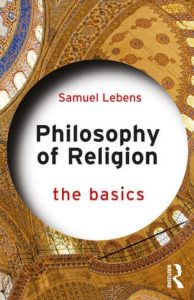
Philosophy of Religion
People who study Jewish philosophy sometimes ask me to recommend an introduction to general philosophy of religion, so as to broaden and deepen their understanding of the issues that Jewish thinkers have perennially addressed. Samuel Lebens’ recent volume, intended as an introduction but highly valuable for specialists as well, is a good choice for several reasons. One is the author’s ever-percolating, imaginative, and incisive mind. Another is his style, which is informal, lively, and lucid, full of colorful examples and pointed formulations. The book also has breadth: Lebens’ fluency in a variety of fields is impressive.
A bit of background will further explain the volume’s significance and character. In perhaps the most striking development in how Jewish philosophy is done today, numerous “analytic” philosophers, many of them Orthodox, create interactions between Jewish and general philosophy. Among those at the forefront of this endeavor isLebens, who is a professor at the University of Haifa, a prolific author, and a musmakh. He has published books with academic presses on both Bertrand Russell and the principles of Judaism; a volume with Koren Publishers proposing reasons to believe; and a large number of articles in both Jewish and general philosophy. Lebens mines Bible, Talmud, Midrash, the classical Jewish philosophers, and Kabbalah to derive philosophical ideas, and likewise mines analytic philosophy to illuminate those sources. The result is a body of original, dynamic thought rooted in tradition. (To the surprise of many, Lebens and some associates have even brought Hasidic thought, particularly its metaphysics, into the realm of analytic philosophy.)
To be clear, this work is not per se about Judaism. In fact, it incorporates analyses of positions in Christianity, Islam, Buddhism, and Hinduism. As a general matter, philosophy of religion has broadened its sweep beyond Christianity to include diverse religions and has expanded its agenda. But for Jewish readers there is something heimish about hearing a philosopher announce his commitment to Orthodoxy, seeing R. Akiva’s joust with Turnus Rufus (Bava Batra 10a) brought against a contemporary atheist philosopher’s version of the problem of evil, hearing Sa‘adya Gaon and R. Jonathan Sacks introduced multiple times, and R. Samson Raphael Hirsch quoted, and encountering a defense of Judah Halevi’s argument for the reality of the revelation at Sinai. Moreover, besides the usual suspects in a philosophy of religion survey—arguments for God’s existence, divine attributes, the problem of evil, and the relationship between religion and ethics—Lebens includes non-standard topics that are of importance to Jews, such as arguments for specific religions, worship, proselytization, and the scope of religious freedom in a democratic society.
I do not agree with Lebens’ every thesis, and you may not either, but this is a fine choice to learn general philosophy of religion. It says a great deal about the strides Jewish philosophy has made that a distinguished non-Jewish press has called upon this particular author for the purpose of introducing philosophy of religion.
Tzvi Ben Meir, Mi She-Sukkato Nofelet (Poalim)
Avraham Walfish

Mi She-Sukkato Nofelet
The title of Tzvi Ben Meir’s debut Hebrew novel, Mi She-Sukkato Nofelet (Whose Sukkah is Falling Down), alludes both to a biblical verse (Amos 9:11), and to a scene in the book in which the wind blows down a flimsy rooftop sukkah built by the main characters, Binny and Esther. Binny—the first-person narrator—and Esther strive mightily throughout the book to maintain the household they have established, but the winds are too powerful and, like the sukkah, the house is too flimsy. This novel is a fictionalized account of the author’s failed marriage, due to a structural flaw: the protagonist’s homosexuality. Despite Binny’s sexual indifference to women, religion and sociology drive him into a marriage doomed from the outset. Leaving no room for surprises, the book opens with a poignant description of giving the get, and continues without chronological sequence, eventually piecing together the narrative trajectory of Binny’s life.
Like the main characters, Religious Zionist society is portrayed in the book sympathetically and affectionately, but marred by flaws which underlie Binny and Esther’s tragically failed marriage. Binny fervently identifies with the values propounded by the yeshiva in which he studies, but in retrospect he realizes that not infrequently religious fervor is grounded less in devotion to God than in conscience, sometimes hyperactive. Most significantly, the atmosphere is pervaded by an expectation of yeshiva students to marry early and build a family, but without corresponding attentiveness to the world of emotions and sexual attraction. Hence, the youthfully innocent Binny and Esther are able to believe that lack of sexual attraction is an obstacle to be overcome, and tellingly Binny’s Rosh Yeshiva encourages them in focusing on their strong bonds of friendship and companionship and downplaying the challenges of Binny’s sexual proclivities.
The drama in this novel is provided by powerful and poignant dialogues. In ongoing conversations with Binny, Esther expresses her growing awareness that their companionship and deep love for one another cannot be sustained in a marital framework without mutual attraction. Binny, torn between his yearning to maintain his connection to Esther and his empathy with her lack of fulfillment, ultimately has to bow to her demands and face the challenge of explaining the situation to his family. While sensitive and sympathetic, Binny’s interlocutors have difficulty in understanding why a marriage of close companionship which seems perfect from the outside cannot overcome a lack of sexual attraction.
There are virtually no unsympathetic characters in this novel, and the characters, like the author, are not looking to assign blame. In one scene, Esther wonders with whom she should be angry—those who failed to educate her to understand the importance of the body and sexuality, with the Rosh Yeshiva who recklessly encouraged the marriage, with the religious world which fails to confront homosexuality and its challenges, with herself? Ultimately, this is not an angry book, but it shines a spotlight on issues which Orthodoxy has not yet adequately addressed.
John L. Hopkins, The World Will Never See the Like: The Gettysburg Reunion of 1913 (Savas Beatie)
Hillel Goldberg
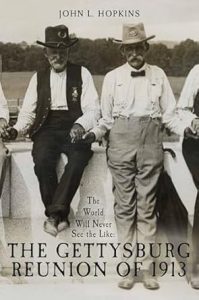
The World Will Never See the Like
First, the bad news. Upon learning about this recent book, I was excited because I thought it could teach something important about the Holocaust. Gettysburg was a bloodbath of historic proportions, and here were veterans, once mortal enemies, coming together half a century later. Surely there was something to learn about remembrance and reconciliation after the Holocaust. The bad news is that this book deals with a very different reality. The good news is that this small volume is filled with powerful human lessons, from forgiveness to fallacies of historical memory.
John L. Hopkins tells the story of how the 50th reunion of the veterans of the pivotal Gettysburg battle in the American Civil War came to be, and it is an interesting political study in itself. But far more interesting is the reunion. It was exactly the opposite of what one might have thought, given the ferocity and the massive death toll of the battle. Soldiers from both the North and the South came in their thousands. If ever there were a gathering whose primary spirit was forgiveness, this was it. There were even cases of individual soldiers who had fought each other, who now recognized each other, with one of the two having been maimed by the other, overwhelming each other with forgiveness. This would stretch credulity if it did not recur again and again, which it did.
Veterans found common ground in having seen the once bitterly divided nation now thriving as a united nation. Herein, however, lies a fallacy of history: reading it through personal lenses that contradict the reality. Many veterans from the South found solace in the “Lost Cause.” It explained the primary stimulus of the Civil War as a conflict over states’ rights, not slavery. Another point in the Lost Cause was that of the contented slave. The Lost Cause provided moral confidence to the losers of the war. This, too, aided in their capacity for forgiveness, whose human dimensions, however, far exceeded any ideological dimension.
Another fallacy of history: spoiler alert. Read how the Southern general who lost the battle for the South managed to polish his reputation as a victim of Robert E. Lee’s incompetence, when the reality was the reverse. Here is a book that lays bare both the marvels and the blind spots of history that affect its direct participants. These lessons can be extrapolated to any work of history.
James Baldwin, Go Tell It on the Mountain (Knopf)
Shalom Carmy, Editor Emeritus
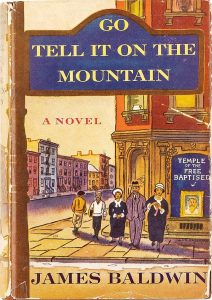
Go Tell It on the Mountain
The young James Baldwin began his career with the semi-autobiographical novel Go Tell It on the Mountain (1953), followed by an essay collection, Notes of a Native Son (1955). The former focuses on a Negro evangelical Protestant church in Harlem, and the older generation’s pre-New York lives. The latter begins there and follows his years of Parisian exile and his first travels in the American South.
The “Negro problem” haunted American life then, and still does, perhaps to a degree that many then and now have difficulty acknowledging. Baldwin remains prominent today for his trenchant observations on the dynamics of the problem. His fundamental insight is that the exclusion of a substantial minority, an oppressed minority, from the promise of American democracy, far from making the Negro invisible, to the contrary engenders a destructive awareness of his presence on both sides. Black people are degraded by their experience of permanent inferiority, suspicion, fear of violence and condescension in the eyes of whites. For Baldwin, this was so in the north; in a different way in the south of overt hostility, institutionally sanctioned. This burden equally deforms the imaginations of whites. Baldwin expressed his position in a memorable 1965 debate with William F. Buckley on whether the American dream is at the expense of the American Negro.
In fiction and in prose, Baldwin shone a harsh light on the realities of black slum life and on the consequences of segregation in his time. Baldwin’s harshness also surfaces in his controversial attempts to explain Negro anti-Semitism (“I remember meeting no Negro in the years of my growing up, in my family or out it, who would really ever trust a Jew, and few who did not, indeed, exhibit for them the blackest contempt.”)
Despite Baldwin’s disdain for the Christian faith of his childhood, Go Tell It on the Mountain contains interesting depictions of his religious community. It might be instructive for some of us to consider what it would mean to take prayer as seriously as some of Baldwin’s characters do. I was also affected by the essay “Equal in Paris.” This Kafkaesque tale illustrates Baldwin’s preoccupations by recounting his arrest for borrowing a bedsheet purloined from a Parisian hotel. He is held incommunicado for a week until an acquitted prisoner summons a lawyer. In Paris, Baldwin is not a Negro, he is an American. Unlike the Negro in America, he has not mastered the rules or language of France and within days, he virtually gives up hope of rescue: since he had lost his father’s God, nothing, he thinks, could help him. While the chapter resonates with anyone who has been kidnapped or imprisoned unjustly, even for a few days, to me it added a deeper apprehension of Joseph’s situation in his Egyptian dungeon.
Jane Austen, Mansfield Park (1814)
Mali Brofsky

Mansfield Park
I have read many interesting and illuminating books this year, but somehow, none that felt noteworthy in the context of the reality we are currently living through. Then, by happenstance, I reread Jane Austen’s Mansfield Park. This is arguably one of Austen’s least popular works, partially because its heroine, Fanny Price, lacks the sparkle, wit, and boldness of characters like Elizabeth Bennet or Emma Woodhouse. By contrast Fanny is passive, timid, and self-effacing. I felt the same way about the book, until I happened upon an introduction to the work by Tony Tanner, British literary critic of the mid-20th century. He argues that for Austen, Fanny represents a set of values that at the time of writing, Austen believed were going out of style and were being replaced by more modern sensibilities. Fanny represents steadfastness, duty, and adherence to classic moral principles. She must be passive, because that is what she represents: at a time when flashiness and change for its own sake were in vogue, all Fanny can do is hold on to her values with persistence. The hope is that, ultimately, values rooted in morality and principles will persevere in the face of the seemingly exciting and daring mores of the time, which ultimately prove to be false and empty.
This is not to say that Austen was against change and progress, or advocated for slavish adherence to older norms simply because they were the status quo. For example, in Mansfield Park, Austen has Fanny questioning—and many critics argue, challenging—her uncle about the slave trade. (Incidentally, when she does so, the room goes silent, as the other, more “modern” characters, are uninterested in such a serious topic, and would much rather return to their frivolous and self-absorbed conversations.) Rather, Austen is arguing in that we treat tradition with respect, and weigh its lessons, particularly those that involve preservation of the good, with careful appreciation and discernment as we move forward, deciding judiciously how to adapt new important principles while maintaining a solid ethical groundwork.
The heart of Mansfield Park lies in Fanny’s ability to hold fast to her principles in a world in which not only the “villains of the piece,” but also some of the more positive characters, are blinded by the façade and temptations of self-serving ideas. This spoke to me this year, as we navigate a reality in which it often feels, here and now in Israel in 2025, that we stand alone as an island in a turbulent sea.
Ilana Redstone, The Certainty Trap: Why We Need to Question Ourselves More―and How We Can Judge Others Less (Pitchstone)
Daniel Z. Feldman
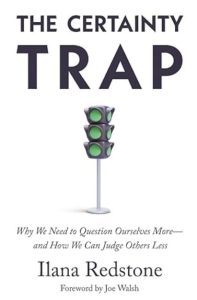
The Certainty Trap
The Certainty Trap, by Ilana Redstone, is subtitled “Why We Need to Question Ourselves More—and How We Can Judge Others Less.” The book’s thesis, quite succinctly described in that phrasing, is one that can provide enormous value towards a host of priorities in the realm of interpersonal halakha. There is a crucial cluster of obligations, including love your fellow as yourself; judging others favorably; avoiding contentiousness; and not speaking nor receiving lashon hara, that are all impacted by unfair judgments of others, whether it is their character that is being judged or, very often, their views and perspectives. Accordingly, a work that focuses its attention on our flawed perceptions in this area can make a great contribution.
Redstone coins a number of “fallacies” which taint our understanding of others, including “The Settled Question Fallacy,” that prematurely removes topics from the realm of debate; and, even more usefully, “The Fallacy of Known Intent,” in which one assumes he or she can correctly infer the motivations of another from that person’s stated positions. The somewhat confusingly named “Fallacy of Equal Knowledge” assumes that others would no doubt agree if only they knew what we knew. While there is some risk in these coinings, as at times the terminology serves (perhaps ironically, in this case) to unfairly disqualify justified beliefs (what may be termed “The Fallacy Fallacy”), overall, there is much to be gained in reducing the unwarranted confidence we often bring towards the attitudes that can lead us to demonize others.
A further summarization of the book’s content that is provided is “I don’t know anything and neither do you.” This may be more sweeping than is necessary for accomplishing the book’s interpersonal goals. In particular, as Orthodox Jews, a formulation that undermines the notion of absolute belief can be unwelcome. However, to focus on a partial application of that statement, in recognizing that our assessments of the character, intelligence, and motivations of others is often, in fact, “fallacious,” can go an enormous distance in making us fairer and more harmonious people.
Mayer Lichtenstein, Musar Avi: Shiurim Be’ikvei Torat Avi Mori HaRav Aharon Lichtenstein zt”l
Shlomo Zuckier
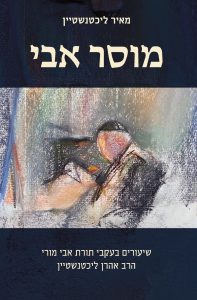
Musar Avi
This Hebrew-language volume by R. Mayer Lichtenstein appeared shortly before the tenth yahrtzeit of his father, Rav Aharon Lichtenstein zt”l. The book is largely composed of memorial shiurim delivered over the past decade by R. Mayer, each engaging an aspect of R. Aharon’s legacy through the lens of one of his published essays.
The book can be divided into two parts. One focuses more directly on R. Aharon’s teachings and personality, while the other presents original hiddushim by R. Mayer that engage topics his father addressed. Both are properly viewed as “lessons following in the path of Rav Aharon,” albeit in different degrees.
The first four chapters focus squarely on R. Aharon’s approach. The opening chapter is R, Mayer’s eulogy delivered at his father’s funeral, and the second reflects on R. Aharon’s impact on the Hesder Yeshivot. Chapters three and four discuss derekh ha-limmud and the model of Hesder (an English translation was published at TraditionOnline), analyzing Rav Aharon’s views and contrasting them with other approaches (that of R. Soloveitchik and Merkaz HaRav, respectively).
Additionally, an appendix at the end of the volume offers “Letters from Abba,” transcriptions (along with some photographs) of fatherly letters R. Aharon wrote to his son, especially during periods of adolescence when the young Mayer spent summers studying with his grandfather, the Rav, in Boston. These letters offer an invaluable window into more personal touch that might not appear in other written works.
Some chapters engage R. Aharon’s writings more directly than others. For instance, the chapter on Kofin al Middat Sedom primarily presents R. Mayer’s reading of rabbinic attitudes toward coercion against Sedom-like economic behaviors. While the piece nods to R. Aharon’s underappreciated article on the topic, and addresses his note that there is a discrepancy between the biblical evil of Sedom and relatively normal (if free market) modes of economic activity, it does not directly engage his father’s central arguments.
The chapters that focus on R. Mayer’s own approach are also deeply argued and engage significant themes in contemporary Jewish thought—halakha and ethics, and emuna u-vittahon. R. Mayer, who leads a community in Beit Shemesh and teaches at Yeshivat Orot Shaul and elsewhere, has established himself as a thoughtful Talmudist and essayist, whose works blend traditional lomdus with academic awareness and are well worth reading in their own right.
For votaries of R. Aharon Lichtenstein, this is a unique volume devoted to his thought, penned by his son and close talmid. For those less familiar with R. Mayer’s own work, the book offers an excellent opportunity to encounter his distinct voice and thoughtful scholarship.
This is the final installment of this year’s picks—see Part I and Part II and peruse our previous lists of TRADITION’s Summer Book Endorsements.
